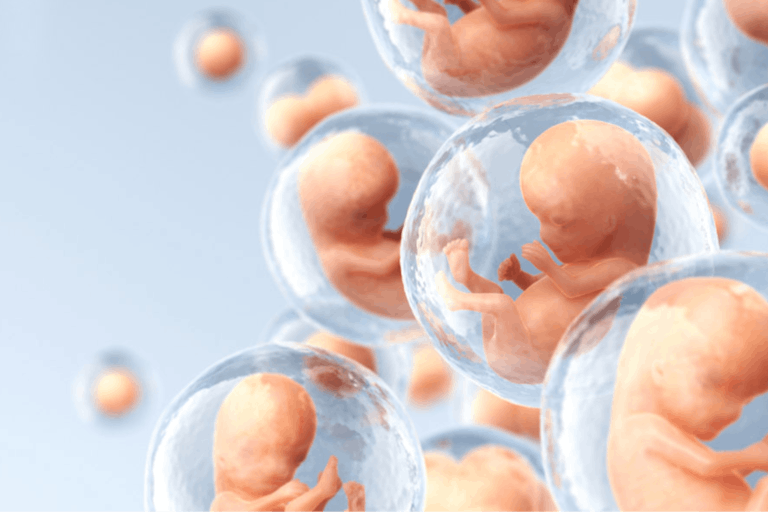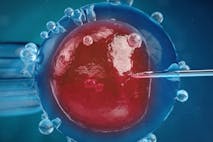
Sharon Osbourne says her kids and grandkids are 'the reason' she's still alive
Cassy Cooke
·
Is there another driving force behind the motivation to fund IVF?
Though some want to mandate insurance companies (and even the government) to pay for IVF to supposedly help couples who are struggling with infertility, one recent news story shows there may be another driving force behind the motivation to fund IVF.
IVF advocates want the expensive process of creating children in a lab to be funded by the government (taxpayers), insurance companies, or both.
While seeking reelection, President Trump said he would ensure that IVF is paid for to 'produce' more children.
One couple recently shared that they saved up their cash and were given grants so they could access IVF — not for infertiity, but so they could use preimplantation genetic diagnosis to avoid having a child with a known genetic health condition.
The push to expand access to IVF may not be entirely about creating more children but also about ensuring certain children aren't born.
As President Trump was running for election last year, he announced that if he won, he would ensure that IVF would be funded, either by the government or by insurance companies.
“The government is going to pay for it, or we’re going to get — we’ll mandate your insurance company to pay for it, which is going to be great. We’re going to do that,” Trump said in August 2024. “We want to produce babies in this country, right?”
But IVF turns children into commodities — treating them as products to be created, graded, and selected rather than as people with human rights. IVF uses labels and a grading system to determine which embryonic children should be given a chance at life and which should be left in limbo or thrown away.
And yet, even experts say the grading process guarantees nothing.
MedPark Hospital explained:
[E]mbryo grading is not straightforward, as a high-scored embryo may not have a successful conception, and one with a [low score] may continue to grow into a high-scored. There are still uncertainties and other variables to consider...
But beyond embryo grading is the systematic destruction of certain embryos created with the goal of testing them for specific genetic conditions — and then destroying them when they test positive.
This is when IVF is used not specifically to combat infertility, but to weed out certain babies to prevent them from being born. This is a form of eugenics.
A couple recently made headlines for 'eliminating' a genetic disease from their family line.
According to news stories, the couple wanted children, but the husband was born with polycystic kidney disease (PKD), which is genetic, and he required kidney transplants as a teenager. As an adult, he takes multiple pills a day to maintain his health. There's a 50/50 chance he will pass PKD on to his children.
"Often there are many family members who have required either dialysis or therapy in the form of a kidney transplant,” said Kevin Schnurr of the PKD-Free Alliance. “And we know, while these are treatments, they're certainly not cures. The only way to effectively remove PKD from future generations is to go the route we're discussing."
The couple, understandably, didn't want their children to have PKD. They saved money to pay for IVF and received a grant to pay for preimplantation genetic diagnosis (PGD) for each of the embryos they created. It cost them about $60,000 and the first embryo did not survive after being transferred.
They were shocked because they were told that embryo was "genetically, chromosomally perfect."
"It's emotional, especially for us. We had lost our first round. I’m thinking, ‘What went wrong? Was it me?’ It was a perfect embryo. Our first one was perfect. She was genetically, chromosomally perfect. What happened?" said the mother.
No matter how "chromosomally perfect" an embryo is, no doctor or parent can ensure a child has perfect health or a perfect life. Even the healthiest of newborns can grow up to have heartbreaking health conditions or suffer an accident. Creating a child classified as "perfect" is unethical and cruel. What child could ever live up to that label? And how easily can that bubble be burst when life gets in the way of perfection?
The second embryo the couple chose did implant and survive, and their baby girl was born in May 2025 by C-section.
"When she came out, he said, 'She's healthy.' And you're just lying there thinking, ‘All the time and all the money, she's healthy. It worked’," said the mother.
But testing their embryos for PKD before implantation did not mean their now-born daughter was prevented from having or cured of PKD. It meant that she never had PKD, and some of her siblings did. Because of that, she was allowed to live, but they were not.
They were destroyed because of their genetic difference. Preimplantation genetic diagnosis screening does not eliminate genetic conditions; it eliminates people.
Article continues below
Dear Reader,
In 2026, Live Action is heading straight where the battle is fiercest: college campuses.
We have a bold initiative to establish 100 Live Action campus chapters within the next year, and your partnership will make it a success!
Your support today will help train and equip young leaders, bring Live Action’s educational content into academic environments, host on-campus events and debates, and empower students to challenge the pro-abortion status quo with truth and compassion.
Invest in pro-life grassroots outreach and cultural formation with your DOUBLED year-end gift!
In fact, the couple created 16 embryos in all. Ten of them had PKD and were presumably destroyed.
Six did not have PKD. The first one chosen did not survive the transfer, and the second did. That should leave four more, but reports say there are three more embryos deemed 'PKD-free,' and the couple wants to transfer the sole male embryo next.
It is unclear if they will attempt to transfer the remaining two girls at any point.
The PKD-Free Alliance exists not to find a cure but to kill off people who have PKD through IVF and PGD.
The PKD-Free Alliance gives funding to couples to pay for their 'imperfect' embryos to be tested and destroyed for failing to meet standards. The organization gave the previously mentioned couple grants of $3,000 and $9,000 to cover the costs of testing and transferring the embryos. The organization, which is attempting to ensure that no child who has PKD is allowed to be born again, works with the medical community and the public to inform people of the available grant money in hopes that more people request it.
This will become more common, except for the high cost. Stanford Medicine recently said (emphasis added):
Preimplantation genetic diagnostic testing during IVF, or PGD-IVF, is being used to screen for single-gene defect conditions such as cystic fibrosis, sickle cell disease and Tay-Sachs disease, along with nearly 400 others.
The problem is that the high cost of IVF - and the lack of coverage by all but one state Medicaid program, that of New York - makes it unavailable to millions of people at risk. The majority of private employer health benefit plans also do not cover IVF...
Although there is a reluctance to add IVF as a benefit to address infertility alone, PGD-IVF would offer insurance organizations a cost-saving intervention when compared with the lifetime costs of care for patients with a single-gene-defect disease.
The Stanford article went on to specifically advocate for the destruction of Black lives.
Sickle cell disease affects 1 out of every 365 Black American babies, and Stanford found that the medical treatments they receive cost between $6,646 and $63,436 more than the average person's health care costs annually. The average lifetime costs of living with sickle cell disease are about $602,000, but can run as high as $1.7 million.
However, using PGD and IVF to "prevent the disease" would cost $15,000 to $25,000, according to Stanford.
This type of cost-savings analysis on human lives is already common in the Canadian government and health insurance companies in pro-euthanasia U.S. states to approve euthanasia for some adults instead of funding their treatments.
This is likely the path that mandated coverage of IVF will take us with preborn children.
President Trump has said he wants a "baby boom" and he has signaled support for IVF in order to make that happen. But forcing insurance companies or even the taxpayers to fund IVF is a possible red flag that the goal of IVF proponents isn't to create more babies, but to ensure certain babies aren't born at all.
Government funding of IVF would likely explode under the auspices of defeating infertility and allowing more children to be born, but could quickly become something dystopian and far more eugenic than many people are currently comfortable with (sex selection, eye color selection, genetic health selection).
It isn't difficult to imagine that allowing widespread access to IVF would quickly create the expectation that people with known genetic differences would stop having children naturally. How far-fetched would it be to think that this could then expand to the expectation that everyone begin using IVF instead of sex to have children, ultimately leading to compulsory genetic testing, PGD, and IVF?
And then at birth, children could ultimately face another round of testing that could find previously undiscovered health conditions. Then what? Child euthanasia? It's already been proposed by some ethicists.
This is the dark future of fertility in the U.S., especially if the government mandates funding.
PGD turns IVF advancements into a search-and-destroy mission that naturally exists in IVF, targeting specific individuals based on their genes. Using PGD to check embryos for any genetic condition or chromosomal difference and then throwing away the ones deemed 'flawed,' is an act of eugenics.
The U.S. simply cannot fund eugenics or force taxpayers to do so.
Live Action News is pro-life news and commentary from a pro-life perspective.
Contact editor@liveaction.org for questions, corrections, or if you are seeking permission to reprint any Live Action News content.
Guest Articles: To submit a guest article to Live Action News, email editor@liveaction.org with an attached Word document of 800-1000 words. Please also attach any photos relevant to your submission if applicable. If your submission is accepted for publication, you will be notified within three weeks. Guest articles are not compensated (see our Open License Agreement). Thank you for your interest in Live Action News!

Cassy Cooke
·
Issues
Angeline Tan
·
Guest Column
Emily Berning
·
Opinion
Nancy Flanders
·
Opinion
Mark Wiltz
·
Opinion
Mark Wiltz
·
Human Interest
Nancy Flanders
·
Analysis
Nancy Flanders
·
Politics
Nancy Flanders
·
Activism
Nancy Flanders
·
Issues
Nancy Flanders
·